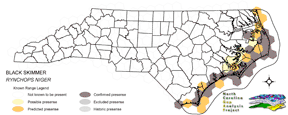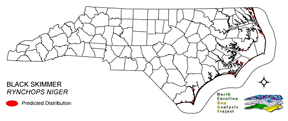
| Taxa: |
| Order: |
| Family: |
| Aves |
| Charadriiformes |
| Laridae |
| NatureServe Global Rank: |
| NatureServe State (NC) Rank: |
| G5 |
| S3B,S3N |
| Federal Status: |
| NC State Status: |
| --- |
| SC |


| Land Unit |
| US Fish & Wildlife Service |
| US Forest Service |
| US National Park Service |
| US Department of Defense |
| NC State Parks |
| NC University System |
| NC Wildlife Res. Com. |
| NC Forest Service |
| NC Div. of Coastal Mgmt. |
| Local Governments |
| Non-Governmental Org. |
| Other Public Lands |
| Private Lands |
| GAP Status 1-2 |
| All Protected Lands |
| Statewide |
| Hectares |
| 13,754.16 |
| 152.01 |
| 7,920.54 |
| 9,665.55 |
| 1,764.99 |
| 3.60 |
| 3,682.35 |
| 0.00 |
| 1,604.07 |
| 7.56 |
| 1,692.27 |
| 34.74 |
| 72,359.91 |
| 26,960.49 |
| 39,798.18 |
| 112,641.75 |
| Acres |
| 33,987.26 |
| 375.62 |
| 19,572.08 |
| 23,884.09 |
| 4,361.38 |
| 8.90 |
| 9,099.28 |
| 0.00 |
| 3,963.74 |
| 18.68 |
| 4,181.69 |
| 85.84 |
| 178,805.20 |
| 66,620.81 |
| 98,343.43 |
| 278,343.77 |
| % of Dist. on |
| Prot. Lands |
| 34.6 % |
| 0.4 % |
| 18.7 % |
| 24.3 % |
| 4.4 % |
| < 0.1 % |
| 9.3 % |
| 0.0 % |
| 4.0 % |
| 4.3 % |
| 4.3 % |
| < 0.1 % |
| 0.0 % |
| 67.7 % |
| ----- |
| ----- |
| % of Dist. on |
| All Lands |
| 12.2 % |
| 0.1 % |
| 7.0 % |
| 8.6 % |
| 1.6 % |
| < 0.1 % |
| 3.3 % |
| 0.0 % |
| 1.4 % |
| < 0.1 % |
| 1.5 % |
| < 0.1 % |
| 64.2 % |
| 23.9 % |
| ----- |
| ----- |
|
Commonly nests along the coast and on the barrier islands (Portnoy 1981). Nests in small to large colonies of generally less than 200 birds on sparsely vegetated (Erwin 1977) barrier and ocean beaches and in salt marshes (Portnoy et al. 1981). Often in association with nesting gulls and terns, especially Common Terns, which may serve as a proximal cue to site selection. Forages by skimming the surface of the water (Erwin 1977). Nests above the high water mark on the upper beach (Erwin 1977). NATURE SERVE GLOBAL HABITAT COMMENTS: Primarily coastal waters, including bays, estuaries, lagoons and mudflats in migration and winter (AOU 1983); also quiet waters of rivers and lakes (Stiles and Skutch 1989). Rest on mudflats, sandbars, beaches. Nests primarily near coasts on sandy beaches, shell banks, coastal and estuary islands, on wrack and drift of salt marshes (especially where traditional beach nesting areas have been lost or where Herring gulls have become abundant), along tropical rivers, salt pond levees (southern California), and locally, on gravelly rooftops; also on dredged material sites. Nests usually in association with or near terns. See Spendelow and Patton (1988) for further details. NATURE SERVE STATE HABITAT COMMENTS: Colonies are usually located on beaches adjacent to inlets or on overwash fans or on bare natural or dredge material islands. |
| Code | Name | Description | NC Natural Heritage Program Equivalent |
| 378 | Ocean Beaches | Open beach sand. | Upper Beach |
| 3 | Tidal Marsh | Fresh and brackish tidal marshes, including cord grass, wild rice, sawgrass and needlerush alliances. | Brackish Marsh, Interdune pond, Maritime wet grassland |
| 375 | Hypersaline coastal salt flats | Tidal flats within salt marshes, including saltmeadow cordgrass or sea-purslane dominated alliances. | Salt Marsh |
| 372 | Interdune Herbaceous Wetlands | Dune swales with permanently flooded to intermittently exposed hydrology. Species composition depends on salinity and can include cut grass, spike-rush, mosquito fern, and hornwort. | Interdune Pond, Maritime Wet Grasslands |
| 371 | Maritime Grasslands | Dune grass community consisting of sea oats and beach grasses. | Dune grass, Maritime dry grassland |
| 202 | Residential Urban | Includes vegetation interspersed in residential areas. Includes lawns, mixed species woodlots, and horticultural shrubs. Vegetation accounts for between 20 - 70% of the cover. | No equivalent |
| 203 | Urban Low-Intensity Developed | Highly developed areas with vegetation accounting for < 20% of the cover. | No equivalent |
| 204 | Urban High-Intensity Developed and Transportation Corridors | Highly developed areas including infrastructure such as roads, railroads. Vegetation represents < 20% of the cover. | No equivalent |
| 8 | Open water | Open water without aquatic vegetation. | No equivalent |
|
Bent, A.C. 1921. Life histories of North American gulls and terns. U.S. Natl. Mux. Bull. 113. Washington, D.C.
Erwin, R.M. 1977. Black skimmer breeding ecology and behavior. Auk 94:709-717. Safina, C., and J. Burger. 1983. Effects of human disturbance on reproductive success in the black skimmer. Condor 85:164-171. Buckley, P. A., and F. G. Buckley. 1984. Seabirds of the north and middle Atlantic coast of the United States:their status and conservation. Pages 101-133 in Croxall et al., eds. Status and conservation of the world's seabirds. ICBP Tech. Pub. No. 2. Clapp, R. B., and P. A. Buckley. 1984. Status and conservation of seabirds in the southeastern United States. Pages 135-155 in Croxall et al., eds. Status and conservation of the world's seabirds. ICBP Tech. Pub. No. 2. Duffy, D. C., and M. Hurtado. 1984. The conservation and status of seabirds of the Ecuadorian mainland. Pages 231-236 in Croxall et al., eds. Status and conservation of the world's seabirds. ICBP Tech. Pub. No. 2. Harrison, C. 1978. A field guide to the nests, eggs and nestlings of North American birds. Collins, Cleveland, Ohio. Terres, J.K. 1980. The Audubon Society encyclopedia of North American birds. Alfred A. Knopf, New York. American Ornithologists' Union (AOU), Committee on Classification and Nomenclature. 1983. Check-list of North American Birds. Sixth Edition. American Ornithologists' Union, Allen Press, Inc., Lawrence, Kansas. National Geographic Society (NGS). 1983. Field guide to the birds of North America. National Geographic Society, Washington, D.C. Hilty, S.L., and W.L. Brown. 1986. A guide to the birds of Colombia. Princeton University Press, Princeton, New Jersey. 836 pp. Spendelow, J.A., and S.R. Patton. 1988. National atlas of coastal waterbird colonies in the contiguous United States:1976-1982. U.S. Fish and Wildlife Service, Biological Report 88(5). x + 326 pp. Stiles, F.G., and A.F. Skutch. 1989. A guide to the birds of Costa Rica. Comstock Publ. Associates, Cornell University Press, Ithaca, New York. 511 pp. Burger, J., and M. Gochfeld. 1990. The black skimmer:the social dynamics of a colonial species. Columbia Univ. Press, New York. 416 pp. |
For more information please contact them at:
NC-GAP Analysis Project
Dept. of Zoology, NCSU
Campus Box 7617
Raleigh, NC 27695-7617
(919) 513-2853
www.basic.ncsu.edu/ncgap